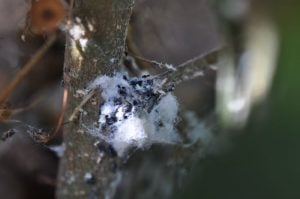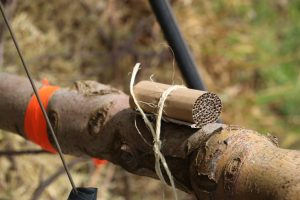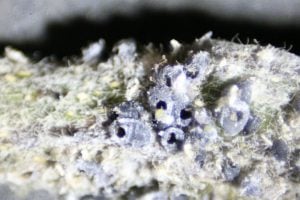The woolly apple aphid (WAA) Eriosoma lanigerum is a serious pest of apple production in all Australian fruit growing regions. It can affect all parts of the tree resulting in direct damage to fruit, limbs, roots and gradual decline in tree health.
The following information is taken directly from the Australian Apple and Pear IPDM manual, and more detailed information can be found by downloading the manual at extensionaus.com.au/ozapplepearipdm

An infestation of Woolly Aphid on the stem of an apple tree with the small wasp parasite to the right and above the aphids and numerous aphid ‘mummies’ – aphid shells with an emergence hole through which a parasitic wasp emerged (Photo: Agriculture Victoria)
Monitoring
In Australia, aerial colonies of WAA are often kept under control as a result of insecticides applied for other pests such as codling moth. Root colonies are more likely to cause serious damage because they escape these insecticides. It’s therefore necessary to monitor the orchard to determine which trees should be treated with a soil drench (see ‘Responsible use of pesticides’, below). During late summer or autumn, apple trees with woolly apple aphid colonies or damage should be identified and marked for treatment early the following season. The presence of established aerial colonies is a good indication that root colonies are also present. Pay attention to old pruning wounds and damaged bark. Brightly coloured plastic flagging is useful for this purpose, but a written record of infested trees should also be kept. A written record ensures that where flagging is blown off or pulled off by birds, trees can still be found and treated. It also provides a useful historical record which can be used to determine how successful pest management has been. Colonies can be assessed using a 1-5 rating score presented in Chapter 3 of the Australian Apple and Pear IPDM manual (see webpage below).
Prevention and good orchard management
Varieties
High density plantings on dwarfing rootstocks return better yields, result in better quality fruit and are becoming the industry norm. However modern dwarfing rootstocks are generally not as resistant to woolly apple infestation as older rootstocks. This problem is exacerbated in high density plantings because Woolly apple aphid moves easily from tree to tree because canopies overlap.
The Merton-Malling series are resistant to woolly apple aphid. The least vigorous of these rootstocks is the semi-dwarfing variety MM102. MM102 provides an option for orchardists with high density blocks where woolly apple aphid is likely to become a problem on more susceptible varieties. Experience in orchards has shown that MM102 is often suitable for replant soils but note that this rootstock is susceptible to Phytophthora and there is limited information on its performance under Australian conditions.
Remove suckers
Suckers or water shoots at the base of the tree and on major scaffold limbs are tender and become a favoured site for the development of early generations of the aphid as it migrates from the roots to the tree canopy. Removal of water shoots removes this convenient bridge.
Pruning
Most of the damage caused by woolly apple aphid occurs below ground therefore pruning can only assist in the management of infestations. Nonetheless summer pruning to remove large colonies will help. Painting large pruning wounds also discourages woolly apple aphid from establishing colonies. Because of their woolly, waxy coating it is difficult to sufficiently wet colonies for insecticides to be effective. Pruning will allow better penetration of canopies with insecticide applications.
Management
In Australia the key to good management of woolly apple aphid is to support biocontrol of the aerial infestations combined with chemical control of the root infesting phase of woolly apple aphid’s life cycle. Applications of insecticides specifically to control aerial colonies of this pest are often unnecessary following effective application of a soil drench.
Responsible use of pesticides
Soil drench. Imidacloprid and Clothianidin are registered for use as soil drenches for the control of woolly apple aphid and the technique for application of these insecticides is similar. The product need only be applied to infested trees identified and marked during the previous season. Application to other trees wastes time and money. A soil drench can be used on trees up to seven years old. Timing is critical and the application needs to be made between green tip and petal fall. Remove any weeds or mulch from around the base of the tree, leaving bare soil. Apply the drench to the soil for a distance of about 15cm from the trunk. Penetration into the soil will be better if it is slightly moist.
The insecticides become less effective after prolonged exposure to sunlight, therefore running micro-sprinklers for an hour after the drench is helpful but not necessary.
In most cases application by hand using a lance sprayer from the back of a four-wheel bike is sufficient. Where a substantial percentage of trees are infested – particularly where they are in the same row – special rigs are available for automated application of products to the base of trees. Some orchardists have expressed concern at the cost of this technique. Dependent on soil type and moisture and the age of the tree it is likely that soil drenches need only be carried out every three years. Careful monitoring of trees should be carried out in the seasons following a soil drench to determine when the next application is needed. Targeted application to infested trees also defrays costs.
Aerial colonies. At times it becomes necessary to apply an insecticide specifically for the control of aerial colonies of woolly apple aphid. Before making this application consider:
▪ Is the problem restricted to one or two trees in a block? Spot sprays cost less money, are usually more effective and will kill fewer predators of orchard pests.
▪ Is it likely that biological control agents (see below) will soon control woolly apple aphid without a pesticide application?
Biological control, biorational pesticides and organics
The parasitoid wasp Aphelinus mali is established in all Australian apple-growing regions. It is particularly effective in warmer areas and seasons. The wasp has a higher developmental threshold temperature than WAA as an adaptation that ensures it becomes active after WAA has progressed beyond the crawler stage. The wasp lays its eggs into the aphid and 1st instar crawlers do not provide adequate food to produce female wasps and only male wasps emerge. By synchronising with development of later WAA instars the wasp ensures it can produce female offspring that can go on to parasitise more WAA. In cooler areas such as the New South Wales Tablelands, Tasmania and parts of Victoria, parasitoid activity may appear to lag behind that of its host and growers think they need to apply a pesticide to control the WAA. The real reason that the WAA infestation is building up is more likely to be that poor choice of sprays against codling moth and LBAM have impacted the parasitoid and the other important predator European earwig. Neither the wasp nor earwig can easily reach the root colonies unless the ground dries up and cracks, so trees with a history of heavy WAA infestations should be treated with a soil drench before the wasps become active.
Aphelinus mali is a parasitoid which lays more than one egg in each of its woolly apple aphid hosts. Eggs can be laid in all stages of aphid growth but the parasitoid only emerges from its host as it approaches adulthood. Parasitised aphids become inflated, lose the ability to secrete their woolly covering and turn into black mummies. The adult wasp emerges from the mummy through a large, irregular hole cut in the back of the aphid abdomen. Before deciding to spray aerial colonies during the season it is important to check the level of activity of Aphelinus mali. Parasitised aphid colonies will have a sparse woolly coating and contain many blackened mummies. If parasitised colonies are widespread it is probably best to delay insecticide application and carefully monitor aphid levels for the next few weeks.

Adult wasps are present in large numbers and can be readily found on the underside of leaves (Photo: Kevin Dodds, NSW DPI)
Earwigs are a great predator
European earwigs are excellent predators of aphids and other pest insects. They can be ‘farmed’ by placing rolled op newspaper of rolled corrugated cardboard bands out in areas where earwigs are likely to congregate, like alongside wooden fences or in amongst stacks of timber and when the rolls have been colonised by the earwigs they can be moved to where WAA infestations need attention.

Earwig shelter made from corrugated cardboard, used to monitor earwig activity (Photo: Kevin Dodds, NSW DPI)
Winter is an opportunity to collect parasitised WAA colonies
The parasitic wasp A.mali can be introduced into unparasitised woolly aphid colonies if you or someone you know already has A.Mali present in parts of an orchard.
During winter pruning, collect infested branches or twigs early in winter, before spraying, and store them in a coolroom (not in a freezer) until mid-spring. The branches or twigs can then be placed in trees showing signs of aphid infestation in early-mid spring. As well as introducing it to an orchard, this method can also be used as a supplement to the wasps that survived in the orchard after your first sprays were applied.
Make sure that the parasitised colonies you are storing have plenty of black mummies that do not have holes in them. The holes indicate the wasp has already emerged.
Other predators worth conserving include syrphid (hover fly) larvae and aphid-eating ladybird beetles such as the common spotted ladybird Harmonia conformis and the transverse ladybird Coccinella transversalis.

Parasitised Woolly Aphid showing exit holes where the adult wasp has emerged (Photo: Kevin Dodds, NSW DPI)
Further Information
For detailed information on Woolly Apple Aphid (including it’s lifecycle, the damage it causes, similar damage caused by other pests) see p307-314 of the Australian Apple and Pear IPDM manual found by downloading the manual at extensionaus.com.au/ozapplepearipdm
Acknowledgements
This article is an excerpt from the Australian Apple and Pear IPDM Manual (2019 edition, HortInnovation), prepared by David Williams1 and Oscar Villalta1 with contributions by Stephen Quarrell2, Kevin Dodds3, Paul James4, Alison Mathews5 and Stewart Learmonth5
1 Agriculture Victoria; 2 TIA; 3 NSW DPI; 4 Lenswood Cooperative, 5 DPIRD WA
